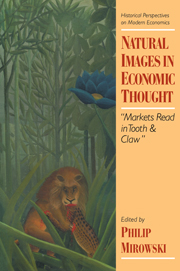Book contents
- Frontmatter
- Contents
- List of contributors
- Acknowledgments
- Part I The Natural and the Social
- Part II Physical metaphors and mathematical formalization
- Part III Uneasy boundaries between man and machine
- Part IV Organic metaphors and their stimuli
- 10 Fire, motion, and productivity: the proto-energetics of nature and economy in François Quesnay
- 11 Organism as a metaphor in German economic thought
- 12 The greyhound and the mastiff: Darwinian themes in Mill and Marshall
- 13 Organization and the division of labor: biological metaphors at work in Alfred Marshall's Principles of Economics
- 14 The role of biological analogies in the theory of the firm
- 15 Does evolutionary theory give comfort or inspiration to economics?
- 16 Hayek, evolution, and spontaneous order
- Part V Negotiating over Nature
- Index
11 - Organism as a metaphor in German economic thought
Published online by Cambridge University Press: 19 January 2010
- Frontmatter
- Contents
- List of contributors
- Acknowledgments
- Part I The Natural and the Social
- Part II Physical metaphors and mathematical formalization
- Part III Uneasy boundaries between man and machine
- Part IV Organic metaphors and their stimuli
- 10 Fire, motion, and productivity: the proto-energetics of nature and economy in François Quesnay
- 11 Organism as a metaphor in German economic thought
- 12 The greyhound and the mastiff: Darwinian themes in Mill and Marshall
- 13 Organization and the division of labor: biological metaphors at work in Alfred Marshall's Principles of Economics
- 14 The role of biological analogies in the theory of the firm
- 15 Does evolutionary theory give comfort or inspiration to economics?
- 16 Hayek, evolution, and spontaneous order
- Part V Negotiating over Nature
- Index
Summary
Introduction
Why go back to those turbid Teutonic tomes written by the likes of Adam Muller, Friedrich List, Albert Schaffle, or Othmar Spann? The attraction has very contemporary explanations. The recent controversy about the relevance of physics to the development of economic theory has kindled a more general discussion on the role of metaphors. It is unclear whether metaphors are just a coincidental device, clearly distinct from the theory's internal structure, or whether they constrain and direct the theory for which they have been appropriated.
To shed some light on this question, it may be helpful to examine the role of biological processes as a source of inspiration for economists. They were, at times, even more popular than physical metaphors. Yet today, biological analogies to economic processes are widely considered a failure. Apparently, then, some metaphors are more successful than others. What caused the failure of biological images? Is it a feature within the biological paradigm, or is it a problem of transferring the basic structure of biological systems to the structure of economies?
This chapter surveys a subset of the biological approaches to economic theory, namely, those based on a comparison between biological “organisms” and economies as parts of social “organisms.” Organic approaches were particularly popular in German thought, and this chapter will restrict itself to German texts. Until the 1930s, organic comparisons were widely considered a viable alternative to mechanistic interpretations of social and economic action.
- Type
- Chapter
- Information
- Natural Images in Economic ThoughtMarkets Read in Tooth and Claw, pp. 289 - 321Publisher: Cambridge University PressPrint publication year: 1994
- 11
- Cited by

